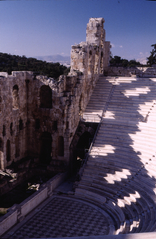Archaeology Reading Group 2006

Athens (Photograph: Andrew Stephenson)
Object-Image-Interpretation
Papers for Semester 2 2006
17 August
Y. Hamilakis (2004) 'Archaeology and the politics of pedagogy' World Archaeology 36.2: 287-309
Electronic download from the Baillieu Library website
Abstract
It is argued here that pedagogy, rather than being a passive process of delivery, is part of the field of cultural politics, a contested domain, a public sphere where knowledges, views and perceptions on the past and the present are debated and contested, or valorized, reproduced and legitimized. Recent archaeological theory has neglected the field of pedagogy, which, as a result, has been largely colonized by the instrumentalist discourse, in its new, market-oriented reincarnation. This dominant view of archaeological pedagogy is presented in objectified, neutral terms as the natural, inevitable course of affairs: it has become the 'doxic' regime that is presented as being beyond criticism at its core, save for peripheral managerial points. Archaeology, however, has the ability to undermine this objectified discourse by showing the contingency, historicity, and the inevitably transient and unstable nature of the present-day pedagogical regime in archaeology. Current instrumentalist pedagogy, despite its dominance, does not go unchallenged. One way of challenging it is by devising pedagogical processes that create a space for critical reflection, reconnect subjectivity and experience with knowledge, and allow students not only to understand the material and social processes that generate and reproduce their own subjectivity, but also question and even transform these processes and conditions. Student-centred journals that promote critical reflexivity are an example of one such pedagogic process. This paper presents the experience of the author in using such a device in the teaching of a course on the archaeology and anthropology of eating and drinking .
14 September
1. A. Petersen (Dec. 2005) 'Politics and narratives: Islamic archaeology in Israel' Antiquity 79.306: 858-865
Electronic download from the Baillieu Library website
Abstract
Whilst this view does have a certain truth, in that the parties involved are locked into a violent day-to-day struggle, the conflict also has an important ideological dimension whereby the cultures are placed in opposition. The ideology was based on the thoughts of Theodor Herzl (1860-1904) and others following the First World Zionist Conference held in Basle in 1897 and began to receive concrete expression in the years following the First World War with the foundation of Jewish settlements in Palestine, the most famous of which was Tel Aviv, next to the Old City of Jaffa. Since the 1980s, the Islamic religious groups have taken an increasingly prominent role, producing tension and sometimes open conflict with the official Palestinian leadership (Fatah), which still sees itself as non-religious, embracing Muslims, Christians, Samaritans and even Jews who are opposed to Zionist expansion. By contrast, the Palestinians have seldom used archaeology as a way of countering Israeli/Zionist claims, preferring to focus instead on living culture such as the embroidered Palestinian dress (Weir 1989) or personal memories of village life (Khalidi 1992; Slymovics 1988; Abu-Ghazelah 1973). However, there is some concern with Islamic material culture in, for example, university geography departments, where it may be studied as historical geography; here it will understandably focus on geographical concerns such as settlement patterns, land use, etc.
2. P. Stone (Dec. 2005) 'The identification and protection of cultural heritage during the Iraq conflict: a peculiarly English tale' Antiquity 79.306: 933-943
Electronic download from the Baillieu Library website
Abstract
The author offers us a first hand account of his extraordinary and unexpected duties during the second Iraq war. This is history, heritage, regulation and perhaps even legislation in the making.
3. C. Chippindale & D.Gill (2001) 'Online auctions: a new venue for the antiquities market' Culture without Context 9
19 October
J. Harding (May 2006) 'Pit-digging, occupation and structured deposition on Rudston Wold, eastern Yorkshire' Oxford Journal of Archaeology 25.2: 109-126
Electronic download from the Baillieu Library website
Abstract
Excavated Neolithic pit clusters, like those found on Rudston Wold in eastern Yorkshire, have often been seen as the remains of occupation sites. The features are interpreted as possessing practical roles, including their use for storing grain, and the incorporated material culture regarded as casually discarded waste. More recent interpretations, however, have emphasized these features' functional unsuitability, rather seeing pit-digging, and the deposition of ideologically-charged objects, as a deliberate attempt to inscribe meaning across a landscape. These two different approaches are considered by a detailed examination of the Peterborough Ware and Grooved Ware associated pits, dug-out swallow-holes and hollows of Rudston Wold. It is argued that their lithic assemblage demonstrates a conventionality best understood as representing occupation at and around the features, themselves once part of small-scale dwellings, but that this material nonetheless resulted from deliberate and purposeful acts which changed during the later Neolithic.
Instructions for downloading electronic resources
- Go to the Library website
- Do a Quick Catalogue Search by Title: eg World Archaeology or JSTOR
- Select the title, which lists the particular journal as an 'electronic resource'.
- Click on the heading Connect (University of Melbourne only)
- You will be asked to provide your last name and bar code number.
- Select the relevant volume and issue.
- Select the file and format (html, pdf) for the article by author.
- Save or print the download.